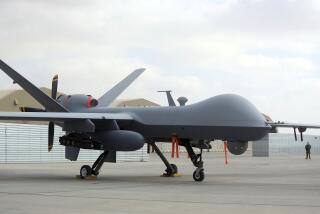NATO, East Bloc Near Accord on ‘Open Skies’ : Surveillance: Shevardnadze predicts ‘agreement in principle’ on overflights. Baker cites ‘vision of a new Europe.’
- Share via
OTTAWA — Thirty-five years after former President Dwight D. Eisenhower proposed it--and after U-2 spy planes and various spy satellites--the “open skies” idea for sanctioned military overflights moved toward reality here Monday with the opening of a 23-nation conference of NATO and Warsaw Pact foreign ministers.
“Agreement in principle” for the concept, in which each military alliance would send aircraft over the other’s territory, was predicted by Soviet Foreign Minister Eduard A. Shevardnadze before the conference ends in two weeks. A full-scale agreement on the confidence-building measure is expected before summer.
“Open skies is potentially the most ambitious measure to build confidence ever undertaken,” Secretary of State James A. Baker III told the conference’s opening session. It is “an integral part of our vision of a new Europe.”
The aircraft would be equipped to take photographs with ordinary and infrared film and with radar. They would also collect other information, including dust samples that could indicate a nuclear test. Only electronic signals would be excluded.
They would fly day or night, in all weather, U.S. officials said. The all-weather capability is important because Eastern Europe is covered by clouds 80% of the year. Until recently, spy satellites could not penetrate clouds or darkness.
The overflights could occur at “any time, any place” within the limits of safety, officials said. Satellites, in contrast, follow a highly predictable course and schedule. It is easy for new weapons and other secret equipment to be hidden when satellites pass over.
Under the plan, Soviet and East European surveillance aircraft would become a common sight over Western Europe, the United States and Canada, while American and West European airplanes would be equally common over the Soviet Union and Eastern Europe.
The open skies treaty, which may later be extended to include the neutral nations of Europe, is not associated with any arms control treaty. But the information gathered under it should complement arms treaties and make smaller nations, particularly those without spy satellites, feel more confident about their security.
While the continuing negotiations for radical cuts in conventional forces in Europe “are the primary means to codify strategic stability in the new Europe,” Baker said, “open skies can and should become a key component of our efforts to increase predictability while also supporting stability.”
Nations will be able to see more clearly than ever before the actions and even the intent of others, including military exercises in which offensive tactics may be practiced, and thus reduce the risk of surprise attacks, he said.
Shevardnadze, whose country rejected Eisenhower’s proposal in 1955 as an attempt to spy, called for extending the principle to “open space and open seas.”
He warned that with increasing access to space technology, nations with “crazy” leaders or even private companies might place in orbit weapons “to endanger mankind.” He urged that an “international space inspectorate” be created to monitor space activities.
He also renewed Moscow’s longstanding proposal for naval arms control. At least, he said, the Warsaw Pact and the North Atlantic Treaty Organization should agree to confidence-building measures such as notice of naval maneuvers and troop transfers.
The United States remains adamantly opposed to any naval arms talks, however, a senior U.S. official said. “This country is an island nation and needs to ensure free sea lanes,” the official commented, noting that, by contrast, the Soviet Union is a land power. Any restrictions on navies are certain to limit the United States more than the Soviet Union, he added.
The open skies idea, revived by President Bush last year, differs somewhat from Eisenhower’s original proposal in that it would cover the two military alliances, NATO and the Warsaw Pact. The 1955 proposal involved only the United States and the Soviet Union.
More to Read
Sign up for Essential California
The most important California stories and recommendations in your inbox every morning.
You may occasionally receive promotional content from the Los Angeles Times.













